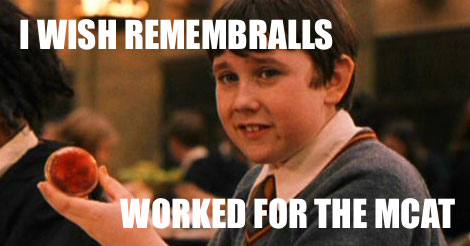How to Become a Flashcard Wizard for the MCAT
- by
- Nov 12, 2019
- Reviewed by: Amy Rontal, MD

Just to be clear, I have a really poor memory. If you and I meet, I’ll likely forget your name. In med school I saw former MCAT students I’ve tutored and not given them a second glance. I’ve forgotten the names of family members I’ve known my whole life, and often have asked my wife to help me figure out who’s married to whom.
Unsurprisingly, I’ve struggled to memorize [seemingly] meaningless information for tests. And yet, I did just fine on the MCAT (and the USMLEs), so I’ve always resisted the idea of focusing on rote memorization.
In my experience, the MCAT has never been a test of simple regurgitation of facts. For example, you’re never asked about the definitions of speed and velocity. You could, however, be asked whether a car driving in circles at a steady 20 mph is changing its speed or velocity; that’s a matter of understanding and application.
And heck, if you can understand all of that well enough, you’ll get that question right and know you don’t need to make a flashcard for this topic!
But there is still a lot more to memorize.
The MCAT test has biochem, which requires a good deal of memorization, no matter how well you understand the subject. And remember what we said about the Psych/Sociology section: It’s got a whole bunch of new concepts and terms that you’ll have to learn through many mental associations.
Also, I have to admit that memorization is really important for the MCAT. So much so that I recommend specifically working on memorizing certain key facts. You’ll still need to do good practice questions to test understanding and application of concepts, but you can and should use flashcards to retain basic knowledge.
What I’ve learned from my experience with memorization:
I’ve been a student for about 30 years, and have used flashcards extensively only in the last few years. (I found they’re especially indispensable for the USMLE exams.) I first really worked to memorize massive quantities of information when studying for the verbal section of the SAT. I started with The Princeton Review’s “Hit Parade.”
Then, when I was doing practice tests and came across any word that I didn’t know confidently, I’d circle it (we used physical books back then. It was all very quaint). I’d compile these words into a vocabulary list and write out short definitions (10 or fewer words) for each term. Though I typed up all of the words, alphabetized them, and planned to rehearse them, I never got around to that last part. Even so, the simple act of writing down and referring to these definitions was enough for me to get a superb SAT score.
Using such a list has its benefits, which is why many others advocate doing something similar for the MCAT. It affords the benefit that comes with writing, is tailored to the specific needs of the person who creates it, and, if done the way I did it, achieves the goal of brevity that I describe below. However, considering the significant time limitations most students face when studying for the MCAT and USMLE, it has a serious limitation: it is very inefficient, for reasons that will soon be clear.
The two types of flashcards:
If you do decide to take the plunge and purchase some 3x5s, here are the two main setups I’ve found work for students, and they serve very different purposes:
1. The “Rolodex” Card
This is a card that succinctly houses all the information you want to know about a given topic in one conveniently accessible place. For example, for a given medical illness, you can write down everything from its diagnosis and etiology to its pathophysiology and treatment. This kind of system is good as a reference. It has much more information than the next kind of card.
2. The True “Flash” Card
This kind of card has one pointed question on one side and the corresponding answer on the other side. This Q&A should not be vague. It should not have multiple possible interpretations — just one clear, discrete response.
In a sense, the The “Rolodex” cards are easier to set up: you list a topic on one side and put as much related information to the topic on the other side. You’re done when you’ve run out of related facts… or space. Usually it’s space that goes first.
However, true “flash” cards can be a bit trickier. Say you want to use flash cards for the following questions: “Pavlov rang a bell in the absence of food, and his dogs salivated. What is the unconditioned stimulus? What is the conditioned stimulus? What is the conditioned response?”
I’ve seen a number of students put all three questions on the same flashcard. However, since there are three questions, there are actually three associations that are being tested — and each true “flash” card should only test one association. So it would be better to repeat the situation on three separate cards and ask one question on each. This would mean also that the three cards would be spaced according to my ability to remember each of those concepts separately and not all three together (see Spaced Repetition below as well as here).
And what if you want to use true “flash” cards to test your understanding of, say, “What holds DNA together?” Well one set of cards I found online gave the answer of “hydrogen bonds,” with a bit more explanatory detail added in. My issue with this card is that hydrogen bonds hold two strands of DNA together, but phosphodiesterase bonds hold the sugar backbone of one strand of DNA together. When using true “flash” cards, I shouldn’t have to decipher which of these questions I’m answering; I’d split this card into two separate ones to test each fact independently.
So which ones are better — rolodex or true “flash” cards? For that matter, what about electronic/app versus paper flashcards?
Our team at MST are huge advocates of flashcards, so I asked them for their input on how to create the best flashcards. Here’s our combined advice:
- If you’re serious about solidifying new facts and associations, use true “flash” cards over “rolodex” ones. It’s counterproductive to fill each flashcard up with information. Use small cards, and write one small point per flash card, even if means making hundreds of them.
- Use a rolodex system if you want to make a system for quick reference. This will be a good idea for studying Drugs & Bugs for the USMLE Step 1 exam. For the MCAT, I could see it being used in Orgo. For example, you list all the reactions you know that alcohols undergo onto one card. If you were making Orgo “Flash” cards, I’d suggest that each reaction get its own card, e.g. with an alcohol and another reagent on the front of the card, and the product on the back.
- Don’t discount the paper flashcard. There’s something to be said about being able to hold a tangible, and manageable, stack of cards in your hand to go through for that day, or the satisfaction of having a growing pile of cards you’ve already mastered.
- Don’t be shy about using colored pens or index cards, and definitely write out the information yourself!
That said, I’m a much bigger fan of online flashcards. Here are some reasons why:
- You can find them ready-made online and easily change them to suit your needs
- You can keep thousands of them on your smartphone, ready to use any time
- You can use spaced repetition for maximum efficiency
Where can I find professionally-made flashcards for the MCAT?
Some resources that we’ve found to help with memorization include Memorang, Firecracker, Scrub Ninjas, and even flashcards from Kaplan that can be used in paper or electronic versions.
You’ve created your flashcards — now, meet spaced repetition.
As some of you may have found, not all flashcard strategies are created equal. For instance, if I make a ton of flashcards and read them over repeatedly in the same order, all I’ll be doing is making a list of facts and rehearsing them — an inefficient and ineffective approach for mastering difficult associations.
In contrast, spaced repetition is a memorization technique that optimizes your flashcard use.
Say, for instance, I decide to review 50 of my flashcards out of my master set. As I flip each card over, I gauge how confident I am in correctly answering the question using a scale of 1-5, with 5 being most confident. Then I sort these cards into corresponding boxes numbered 1-5. Since I am confident in my knowledge of the #5 box material, I label that box of flashcards to be reviewed two weeks from now. The #4 box I will review again perhaps 8 days from now, the #3 box perhaps 5 days from now, the #2 box 3 days from now and the #1 box 1 day from now. This system enables me to prioritize the information on my flashcards: I defer reviewing more familiar material so I can solidify my understanding of the most difficult topics.
For your reference, there are also different methods, algorithms, and goals for spaced repetition. For example, there’s the Leitner system and Wozniak’s algorithm. Some systems have options to choose whether you got the answer right or wrong only, while others have you grade your confidence. Some require you to get a question right a certain number of times before spacing it out into the future, while others immediately delay repetition after one correct response. While each approach has its own merits, every one is a vast improvement over not using spaced repetition.
Your laptop, tablet or smartphone can automate the spaced repetition of your flashcards by sorting the cards and telling you which ones are “due” that day. You simply choose the strategy to use, how often cards should come up, and which deck(s) of cards to sort. Currently, I use the website Cram to make/find flashcards, and this app to review them on my phone, largely because both are free. But there are many other options out there for you.
When should I use these cards?
As I said above, memorization is a necessity on this new test. Flashcards can be a particularly convenient tool to help you reach your MCAT goal; after all, you can quiz yourself during time you’d ordinarily waste!
Traveling on a crowded subway? If you have room to put your phone near your face, you can study flashcards.
Unexpected line, stuck somewhere without your books or phone service, bored somewhere where you’d normally pass the time by texting? Go through some flashcards instead!
Too tired to read texts or do novel practice problems? Use that time to review simple associations with vaguely familiar terms.
Is it the end of the day and you’re so tired that you can’t even do flashcards and are looking for an unproductive time killer? Instead, spend that time going through materials you need work on and make some new flashcards out of them.
Basically, make writing and reviewing flashcards part of your daily routine. Don’t worry about what you don’t remember or how many you need to do that day. Let the app do all that thinking for you, and just treat it like a simple brain teaser game. You’ll be amazed at how much more easily and quickly you’re retaining and recalling pertinent information, and how you managed to go so long without using this technique.









